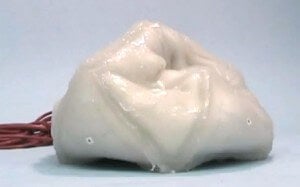
Like some sort of pulsating alien soccer ball, iRobot‘s blob robot expands and contracts to roll around and creep you out. Part of the chemical robots (chembots) $3.3 million project funded by DARPA, the blob bot is a prototype designed to one day squeeze through openings much smaller than it’s fully inflated size. Great idea, iRobot, give the mechanical monstrosity the ability to seep under doors. Now, nowhere is safe. The robot recently debuted at IROS, the joint IEEE and RSJ conference on intelligent bots. Make sure to check out the video from IEEE Spectrum after the break, but if you just want to see the bot in action go to 1:49 and skip an explanation on how it all works.
There are many things the modern soldier is capable of, but traveling through the cracks in a wall isn’t one of them. DARPA commissioned the chembots project to help find novel ways that robots could move such that they could get to places where humans, and conventional wheeled robots, cannot. If iRobot, or another manufacturer is successful, such new chembots could help locate injured people after a building collapse, or find secreted explosives, or perform reconnaissance in a building the enemy thinks is secure.
As the video mentions, the blob bot moves through a system call jamming skin enabled locomotion. JSEL takes advantage of the liquid-like behavior of small particles in a partially inflated sac. When inflated, such sacs deform and move freely. When air is evacuated, the small particles jam together, providing rigid support and structure. The blob bot is built of a shell of many jammable silicone sacs with a central fluid reservoir in the center. By controlling pressure in each sac and the center reservoir, the blob can expand and contract in order to flop around. It’s eerie and awesome at the same time.
IEEE reports that the version of the robot shown in the video is actually representative of development around one year ago. The current version of the bot is closer to incorporating sensors, and perhaps joining different copies of the robot together. I wonder if it still requires outside wires and tubes to control air flow, however. While the movement produced by this bot is unique, inflating and deflating sacs would seem to require an outside air supply (or compressor pump). To me, that necessity is a major draw back to eventually building an autonomous (and wireless) field model. But who knows, iRobot could simply be using the blob bot as a proof of concept for a different robot altogether, who’s eventual design may be nothing like what we see here.
No matter what iRobot eventually produces under the chembot umbrella, the movement we’ve seen in blob bot is remarkable. I haven’t seen a robot wiggle around in such an interesting manner since we discussed modular robotics a few months ago. Perhaps in the near future iRobot will demonstrate a prototype that can actually squeeze through a small aperture. When that happens, it’ll be time to buy some duct tape and seal up the house. What would you rather have, safety from robots or oxygen? I’ll assume passing out is a vote for safety.
[screen capture and video credit: IEEE Spectrum]


